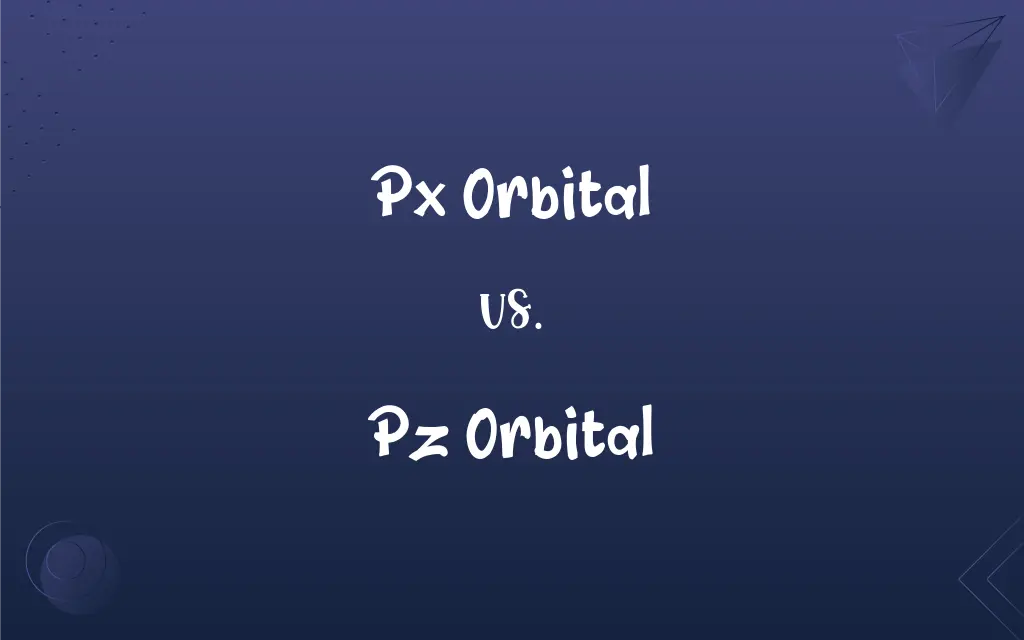Px Orbital vs. Pz Orbital: What's the Difference?
Edited by Aimie Carlson || By Janet White || Published on February 15, 2024
Px orbital is oriented along the x-axis, while pz orbital is oriented along the z-axis in an atom's electron cloud.

Key Differences
The px orbital is oriented along the x-axis of a Cartesian coordinate system. This means it extends left and right from the nucleus. In contrast, the pz orbital is aligned along the z-axis, which typically denotes the vertical axis in a three-dimensional space, extending above and below the nucleus.
Both px and pz orbitals are part of the p orbital category, which have a dumbbell-shaped electron cloud. The difference lies in the orientation: the px orbital’s electron cloud is horizontally elongated, whereas the pz orbital's cloud is vertically elongated.
In a single atom, px, py, and pz orbitals have the same energy level (they are degenerate) in the absence of an external electric or magnetic field. However, their spatial orientations give them unique properties when interacting with external fields or forming molecular bonds.
In molecular formation, the orientation of px orbitals affects how atoms align and bond with each other in the x-axis direction. Similarly, pz orbitals play a crucial role in vertical bonding alignments along the z-axis, influencing molecular shape and structure.
The distribution of electrons in px and pz orbitals can impact an atom's reactivity and interactions. For example, in complex molecules, the spatial orientation of these orbitals influences how electrons are shared or transferred during chemical reactions.
ADVERTISEMENT
Comparison Chart
Orientation
Along the x-axis (horizontal)
Along the z-axis (vertical)
Shape
Dumbbell-shaped, horizontal elongation
Dumbbell-shaped, vertical elongation
Energy Level
Degenerate with other p orbitals
Degenerate with other p orbitals
Role in Molecular Bonding
Affects horizontal bonding alignments
Influences vertical bonding alignments
Electron Distribution Impact
Impacts reactivity in the x-axis direction
Influences reactivity in the vertical direction
ADVERTISEMENT
Px Orbital and Pz Orbital Definitions
Px Orbital
Px orbital is a p-type orbital oriented along the x-axis.
The px orbital influences the horizontal electron cloud distribution in the atom.
Pz Orbital
Pz orbital is a p-type orbital oriented along the z-axis.
The pz orbital extends vertically from the nucleus, affecting vertical electron distribution.
Px Orbital
Px orbital is involved in electron sharing horizontally.
Electrons in the px orbital are delocalized in conjugated systems.
Pz Orbital
Pz orbital is involved in vertical electron sharing.
In a molecule, pz orbitals can overlap to form pi bonds.
Px Orbital
Px orbital contributes to the atom's bonding and reactivity.
The overlap of px orbitals is crucial in the formation of sigma bonds.
Pz Orbital
Pz orbital is essential in vertical bonding in molecules.
Pz orbitals are involved in pi bonding in double bonds.
Px Orbital
Px orbital has a dumbbell shape extending horizontally.
In benzene, the px orbitals play a role in the planar structure of the molecule.
Pz Orbital
Pz orbital has a dumbbell shape extending vertically.
Vertical electron cloud in pz orbital contributes to the molecule's linear geometry.
Px Orbital
Px orbital is degenerate with py and pz orbitals.
In a magnetic field, the energy of the px orbital can differ from the py and pz.
Pz Orbital
Pz orbital is degenerate with px and py orbitals.
In a crystal field, the energy of pz orbital can be different from px and py.
FAQs
Are px and pz orbitals degenerate?
Yes, they have the same energy level.
How do px and pz orbitals differ in orientation?
Px is horizontal, pz is vertical.
What shape do px and pz orbitals have?
Both have a dumbbell shape.
How does the px orbital affect molecular bonding?
It influences horizontal bonding patterns.
What role does the pz orbital play in molecules?
It's crucial for vertical bonding arrangements.
Can px and pz orbitals participate in pi bonding?
Yes, particularly pz orbitals.
What is a px orbital?
A p-type orbital oriented along the x-axis.
How do external fields affect px and pz orbitals?
They can alter their energy levels and orientations.
Are pz orbitals involved in double bonds?
Yes, particularly in pi bond formation.
Do px and pz orbitals influence chemical reactivity?
Yes, based on their electron distribution and orientation.
How do px and pz orbitals affect molecular geometry?
They influence the shape by their directional electron cloud distribution.
What is a pz orbital?
A p-type orbital oriented along the z-axis.
Do px orbitals participate in delocalized electron systems?
Yes, particularly in conjugated systems.
What type of bonds do px orbitals form in molecules?
Mainly sigma bonds due to head-on overlap.
Can px orbitals interact with py orbitals?
Yes, in certain molecular configurations.
What happens to pz orbitals in a linear molecule?
They align along the molecule's vertical axis.
Do px orbitals affect atom's reactivity in a specific direction?
Yes, in the horizontal direction along the x-axis.
How does electron sharing differ in px and pz orbitals?
Px shares electrons horizontally, pz vertically.
Can pz orbitals be involved in hybridization?
Yes, like in sp or sp2 hybridizations.
Are px and pz orbitals always oriented strictly along axes?
In molecules, their orientation can be influenced by the overall molecular geometry.
About Author
Written by
Janet WhiteJanet White has been an esteemed writer and blogger for Difference Wiki. Holding a Master's degree in Science and Medical Journalism from the prestigious Boston University, she has consistently demonstrated her expertise and passion for her field. When she's not immersed in her work, Janet relishes her time exercising, delving into a good book, and cherishing moments with friends and family.
Edited by
Aimie CarlsonAimie Carlson, holding a master's degree in English literature, is a fervent English language enthusiast. She lends her writing talents to Difference Wiki, a prominent website that specializes in comparisons, offering readers insightful analyses that both captivate and inform.







































































